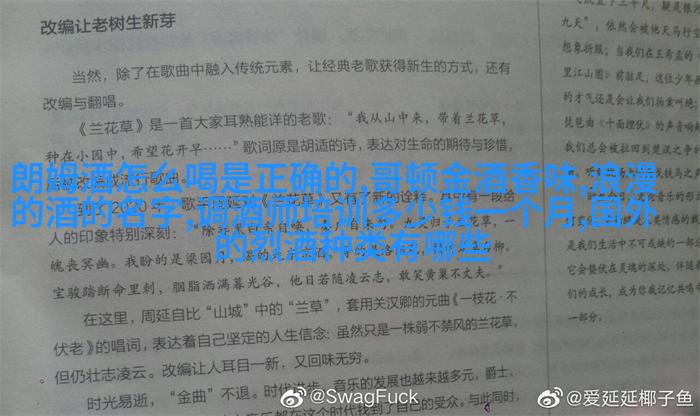冬酿花雕的起源与历史

冬酿花雕是一种传统中国白酒,起源于山东省菏泽市的单县。据说,这款酒最早是在清朝时期,由当地的一位名叫王国轩的士绅所创造。他在自己家中自行研制了一种独特的发酵技术,将传统的小麦、玉米和糯米等原料通过独特的发酵工艺混合成一种浓郁而不失细腻口感的美酒。这款酒最初被称为“单县老窖”,后来因为其特殊的生产工艺和独有的风味,被人们称为“冬酿花雕”。
冬酿花雕制作过程

冬酿花雕之所以得名,是因为它采用的生产工艺涉及到长时间的大规模冷藏保存。在整个发酵过程中,必须严格控制温度,以保证微生物活性不会过快增长,从而影响产品质量。在这个过程中,每一步都需要极高的心理素质和专业技能。例如,在将已经初步发 酵后的曲液入窖前,还需进行一系列精细化处理,如调整温度、密度等,以达到最佳状态。
冬酿花葶品质评价

品质上,冬季寒冷可以使得葡萄糖分解更加均匀,同时也能促进提取物质更好地溶出,使得最终产出的酒体更加透明且色泽金黄。至于风味,则是多层次复杂,一般来说会有果香、麸香和木材香三大类,其中麸香尤其突出,这也是这款白酒深受喜爱的一个原因。
保护文化传承与现代发展

在全球化背景下,对于这种珍贵文化遗产,其保护显得尤为重要。因此,不仅要继续推广这门技艺,也要加强对相关知识的普及,让更多的人了解并尊重这一文化遗产。而对于现代社会而言,如何将这些传统手法与现代管理体系相结合,更好地适应市场需求也是一个值得探讨的话题。
5.Winter Flower Wine: A Story of Ancient Flavors and Modern Appeal

Winter flower wine, a traditional Chinese spirit from Shandong Province, has been passed down for generations since its creation in the Qing Dynasty by Wang Guoxuan, a local scholar-official who perfected his unique fermentation technique using rice, wheat, and corn to create an aromatic yet refined beverage called "Single County Old Cellar," later known as "Winter Flower Wine."
The Production Process of Winter Flower Wine
This name is derived from the fact that it employs cold storage techniques during fermentation processes over long periods at controlled temperatures to ensure microbial activity does not accelerate excessively and negatively impact product quality.
7.Winter Flower Wine's Quality Evaluation
8.The process involves fine-tuning temperature and density adjustments before transferring the initial fermented liquid into cellars for further processing under optimal conditions.
9.Preservation of Cultural Heritage & Contemporary Development
10.The spirit's unique flavor profile features fruit notes, musty aromas (a characteristic often associated with aged wines), wood notes—particularly prominent among them—is one reason why this white spirit is cherished worldwide.
11.Combining Traditional Techniques with Modern Management Systems in Today's Market
12.Facing globalization challenges on preserving such cultural legacies requires promoting these arts while educating people about their significance so they can respect these intangible assets more fully.
13.Integrating ancient brewing methods with contemporary management strategies to meet modern market demands remains an open question worth exploring further.
